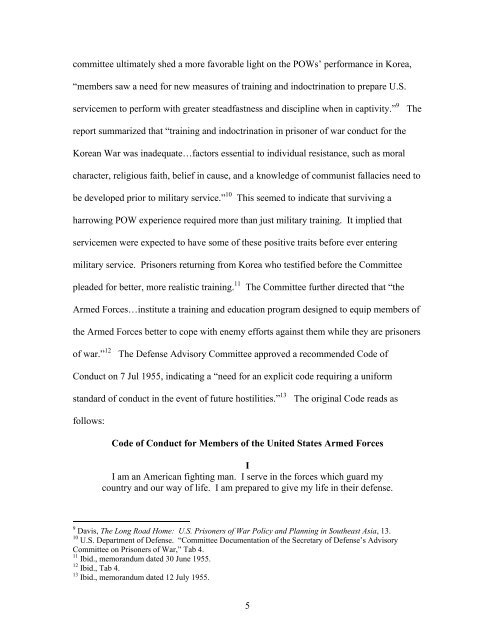Performance of American Pows in the Vietnam War - The Black Vault
Performance of American Pows in the Vietnam War - The Black Vault
Performance of American Pows in the Vietnam War - The Black Vault
Create successful ePaper yourself
Turn your PDF publications into a flip-book with our unique Google optimized e-Paper software.
committee ultimately shed a more favorable light on <strong>the</strong> POWs’ performance <strong>in</strong> Korea,<br />
“members saw a need for new measures <strong>of</strong> tra<strong>in</strong><strong>in</strong>g and <strong>in</strong>doctr<strong>in</strong>ation to prepare U.S.<br />
servicemen to perform with greater steadfastness and discipl<strong>in</strong>e when <strong>in</strong> captivity.” 9<br />
<strong>The</strong><br />
report summarized that “tra<strong>in</strong><strong>in</strong>g and <strong>in</strong>doctr<strong>in</strong>ation <strong>in</strong> prisoner <strong>of</strong> war conduct for <strong>the</strong><br />
Korean <strong>War</strong> was <strong>in</strong>adequate…factors essential to <strong>in</strong>dividual resistance, such as moral<br />
character, religious faith, belief <strong>in</strong> cause, and a knowledge <strong>of</strong> communist fallacies need to<br />
be developed prior to military service.” 10<br />
This seemed to <strong>in</strong>dicate that surviv<strong>in</strong>g a<br />
harrow<strong>in</strong>g POW experience required more than just military tra<strong>in</strong><strong>in</strong>g. It implied that<br />
servicemen were expected to have some <strong>of</strong> <strong>the</strong>se positive traits before ever enter<strong>in</strong>g<br />
military service. Prisoners return<strong>in</strong>g from Korea who testified before <strong>the</strong> Committee<br />
pleaded for better, more realistic tra<strong>in</strong><strong>in</strong>g. 11<br />
<strong>The</strong> Committee fur<strong>the</strong>r directed that “<strong>the</strong><br />
Armed Forces…<strong>in</strong>stitute a tra<strong>in</strong><strong>in</strong>g and education program designed to equip members <strong>of</strong><br />
<strong>the</strong> Armed Forces better to cope with enemy efforts aga<strong>in</strong>st <strong>the</strong>m while <strong>the</strong>y are prisoners<br />
<strong>of</strong> war.” 12<br />
<strong>The</strong> Defense Advisory Committee approved a recommended Code <strong>of</strong><br />
Conduct on 7 Jul 1955, <strong>in</strong>dicat<strong>in</strong>g a “need for an explicit code requir<strong>in</strong>g a uniform<br />
standard <strong>of</strong> conduct <strong>in</strong> <strong>the</strong> event <strong>of</strong> future hostilities.” 13<br />
<strong>The</strong> orig<strong>in</strong>al Code reads as<br />
follows:<br />
Code <strong>of</strong> Conduct for Members <strong>of</strong> <strong>the</strong> United States Armed Forces<br />
I<br />
I am an <strong>American</strong> fight<strong>in</strong>g man. I serve <strong>in</strong> <strong>the</strong> forces which guard my<br />
country and our way <strong>of</strong> life. I am prepared to give my life <strong>in</strong> <strong>the</strong>ir defense.<br />
9 Davis, <strong>The</strong> Long Road Home: U.S. Prisoners <strong>of</strong> <strong>War</strong> Policy and Plann<strong>in</strong>g <strong>in</strong> Sou<strong>the</strong>ast Asia, 13.<br />
10 U.S. Department <strong>of</strong> Defense. “Committee Documentation <strong>of</strong> <strong>the</strong> Secretary <strong>of</strong> Defense’s Advisory<br />
Committee on Prisoners <strong>of</strong> <strong>War</strong>,” Tab 4.<br />
11 Ibid., memorandum dated 30 June 1955.<br />
12 Ibid., Tab 4.<br />
13 Ibid., memorandum dated 12 July 1955.<br />
5

















